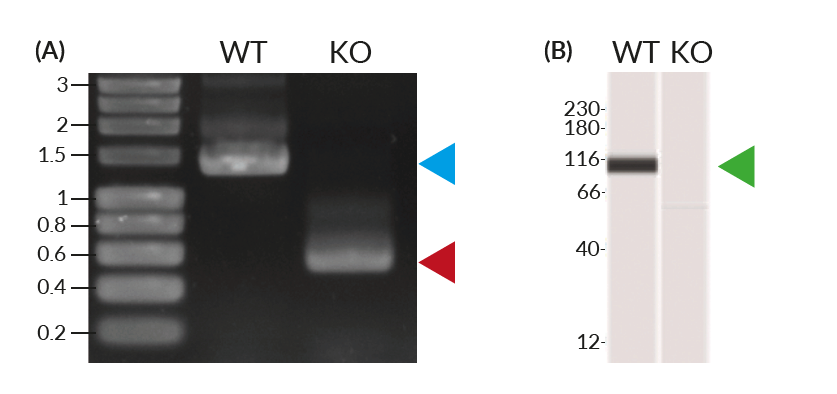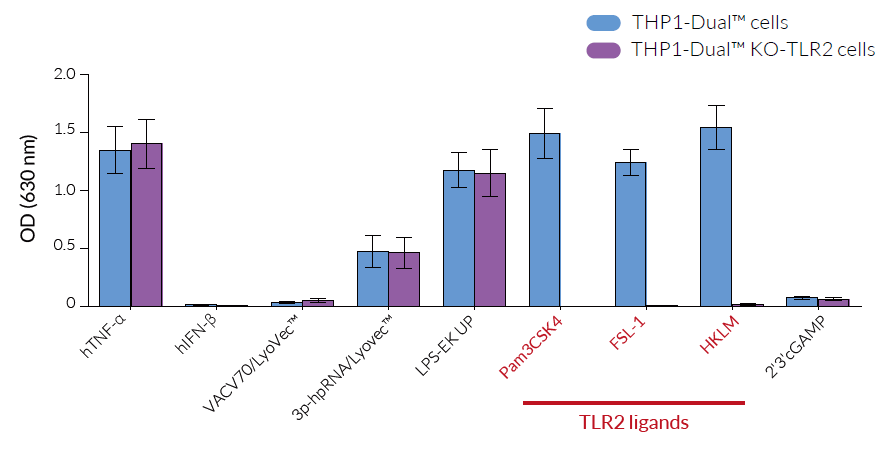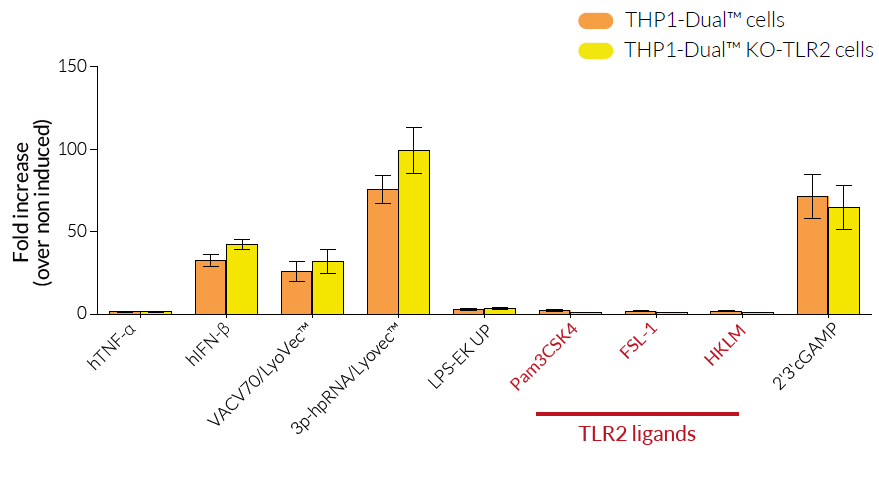TLR2 KO Dual Reporter THP-1 Cells
| Product | Unit size | Cat. code | Docs. | Qty. | Price | |
|---|---|---|---|---|---|---|
|
THP1-Dual™ KO-TLR2 Cells TLR2 knockout NF-κB-SEAP and IRF-Lucia Reporter Cells - THP-1 Reporter Monocytes |
Show product |
3-7 x 10e6 cells |
thpd-kotlr2
|
|
||
|
THP1-Dual™ KO-TLR2 vial Additional cell vial |
Show product |
3-7 x 10e6 cells |
thpd-kotlr2-av
|
Notification: Reference #thpd-kotlr2-av can only be ordered together with reference #thpd-kotlr2.
TLR2 knockout dual reporter monocytes

NF-κB and IRF signaling pathways in THP1-Dual™ KO-TLR2 cells
InvivoGen offers a human monocyte-derived cell line specifically designed for the study of human TLR2 (Toll-like receptor 2) function:
• THP1-Dual™ KO-TLR2 cells
THP1-Dual™ KO-TLR2 cells were generated from the THP1-Dual™ cell line through the stable knockout of the TLR2 gene. They feature two inducible reporter genes, allowing the concomitant study of the IRF and NF-κB pathways, by monitoring the Lucia luciferase and SEAP (secreted embryonic alkaline phosphatase) activities, respectively.
As expected, the NF-κB-mediated response is abolished in THP1-Dual™ KO-TLR2 cells upon incubation with TLR2-specific ligands such as Pam3CSK4 (TLR2/1), FSL-1 (TLR2/6), and heat-killed Listeria monocytogenes (HKLM; TLR2/6) when compared to the THP1-Dual™ cells, with no notable difference for the other ligands tested. Additionally, as TLR2 does not directly signal through an IRF-dependent pathway, the secretion of Lucia luciferase is unaltered in THP1-Dual™ KO-TLR2 when tested across a range of IRF-inducing ligands (see Figures).
Background:
Toll-like receptor 2 (TLR2) plays an essential role in detecting a diverse range of microbial pathogen-associated molecular patterns (PAMPs) from bacteria, fungi, and parasites, including lipoproteins, lipoteichoic acid, lipoarabinomannan, and chitin [1]. A number of viruses have also been shown to interact directly with TLR2, including HIV and herpes simplex virus [1, 2]. TLR2 forms a heterodimer on the cell surface with either of its co-receptors, TLR1 or TLR6, which is crucial for signaling and ligand specificity. The TLR2/TLR1 and TLR2/TLR6 heterodimers specifically bind lipoproteins depending on whether they are tri- or diacylated, respectively [1]. Their activation triggers NF-κB- and AP-1-mediated pro-inflammatory responses [3].
![]() Learn more about TLR2 heterodimers.
Learn more about TLR2 heterodimers.
Key Features:
- Verified knockout of the TLR2 gene (PCR, DNA sequencing, and functional assays)
- Functionally validated with a selection of PRR ligands and cytokines
- Readily assessable Lucia luciferase and SEAP reporter activities
Applications:
- Defining the role of TLR2 in PRR-induced signaling, or related cell signaling pathways
- Exclusion of contaminating TLR2 agonist-dependent (e.g. bacterial lipoproteins) signaling
- Highlighting possible overlap between TLR2 and other signaling pathways
References
1. Oliveira-Nascimento, L. et al. 2012. The Role of TLR2 in Infection and Immunity. Front Immunol 3, 79.
2. Henrick, B.M. et al. 2015. HIV-1 Structural Proteins Serve as PAMPs for TLR2 Heterodimers Significantly Increasing Infection and Innate Immune Activation. Front Immunol 6, 426.
3. Li, J. et al. 2013. Evolving Bacterial Envelopes and Plasticity of TLR2-Dependent Responses: Basic Research and Translational Opportunities. Front Immunol 4, 347.
Specifications
Growth medium: RPMI 1640, 2 mM L-glutamine, 25 mM HEPES, 10% (v/v) fetal bovine serum (FBS), 100 U/ml penicillin, 100 µg/ml streptomycin, 100 µg/ml Normocin™
Antibiotic resistance: Blasticidin and Zeocin®
Quality Control:
- Biallelic TLR2 knockout has been verified by PCR, DNA sequencing, and functional assays.
- The stability for 20 passages, following thawing, has been verified.
- These cells are guaranteed mycoplasma-free.
Contents
- 3-7 x 106 THP1-Dual™ KO-TLR2 cells in a cryovial or shipping flask
- 1 ml of Normocin™ (50 mg/ml). Normocin™ is a formulation of three antibiotics active against mycoplasmas, bacteria, and fungi.
- 1 ml of Zeocin® (100 mg/ml)
- 1 ml of Blasticidin (10 mg/ml)
- 1 tube of QUANTI-Luc™ 4 Reagent, a Lucia luciferase detection reagent (sufficient to prepare 25 ml)
- 1 ml of QB reagent and 1 ml of QB buffer (sufficient to prepare 100 ml of QUANTI-Blue™ Solution, a SEAP detection reagent)
![]() Shipped on dry ice (Europe, USA, Canada, and some areas in Asia)
Shipped on dry ice (Europe, USA, Canada, and some areas in Asia)










